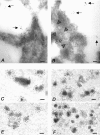Induction of lymphocyte apoptosis by tumor cell secretion of FasL-bearing microvesicles
- PMID: 12021310
- PMCID: PMC2193755
- DOI: 10.1084/jem.20011624
Induction of lymphocyte apoptosis by tumor cell secretion of FasL-bearing microvesicles
Abstract
The hypothesis that FasL expression by tumor cells may impair the in vivo efficacy of antitumor immune responses, through a mechanism known as 'Fas tumor counterattack,' has been recently questioned, becoming the object of an intense debate based on conflicting results. Here we definitely show that FasL is indeed detectable in the cytoplasm of melanoma cells and its expression is confined to multivesicular bodies that contain melanosomes. In these structures FasL colocalizes with both melanosomal (i.e., gp100) and lysosomal (i.e., CD63) antigens. Isolated melanosomes express FasL, as detected by Western blot and cytofluorimetry, and they can exert Fas-mediated apoptosis in Jurkat cells. We additionally show that melanosome-containing multivesicular bodies degranulate extracellularly and release FasL-bearing microvesicles, that coexpress both gp100 and CD63 and retain their functional activity in triggering Fas-dependent apoptosis of lymphoid cells. Hence our data provide evidence for a novel mechanism potentially operating in Fas tumor counterattack through the secretion of subcellular particles expressing functional FasL. Such vesicles may form a sort of front line hindering lymphocytes and other immunocompetent cells from entering neoplastic lesions and exert their antitumor activity.
Figures














Similar articles
-
The human melanoma cell line MelJuSo secretes bioactive FasL and APO2L/TRAIL on the surface of microvesicles. Possible contribution to tumor counterattack.Exp Cell Res. 2004 May 1;295(2):315-29. doi: 10.1016/j.yexcr.2003.12.024. Exp Cell Res. 2004. PMID: 15093732
-
Fas ligand-positive membranous vesicles isolated from sera of patients with oral cancer induce apoptosis of activated T lymphocytes.Clin Cancer Res. 2005 Feb 1;11(3):1010-20. Clin Cancer Res. 2005. PMID: 15709166
-
Human melanoma-reactive CD4+ and CD8+ CTL clones resist Fas ligand-induced apoptosis and use Fas/Fas ligand-independent mechanisms for tumor killing.J Immunol. 1998 Aug 1;161(3):1220-30. J Immunol. 1998. PMID: 9686582
-
Immunity to cancer: attack and escape in T lymphocyte-tumor cell interaction.Immunol Rev. 2002 Oct;188:97-113. doi: 10.1034/j.1600-065x.2002.18809.x. Immunol Rev. 2002. PMID: 12445284 Review.
-
Inhibition of Fas/Fas ligand-mediated apoptotic cell death of lymphocytes in vitro by circulating anti-Fas ligand autoantibodies in patients with systemic lupus erythematosus.Arthritis Rheum. 1998 Feb;41(2):344-53. doi: 10.1002/1529-0131(199802)41:2<344::AID-ART19>3.0.CO;2-J. Arthritis Rheum. 1998. PMID: 9485093 Review.
Cited by
-
Increased Plasmatic Levels of Exosomes Are Significantly Related to Relapse Rate in Patients with Oral Squamous Cell Carcinoma: A Cohort Study.Cancers (Basel). 2023 Dec 2;15(23):5693. doi: 10.3390/cancers15235693. Cancers (Basel). 2023. PMID: 38067397 Free PMC article.
-
Diagnostic and Therapeutic Applications of Exosomes in Cancer with a Special Focus on Head and Neck Squamous Cell Carcinoma (HNSCC).Int J Mol Sci. 2020 Jun 18;21(12):4344. doi: 10.3390/ijms21124344. Int J Mol Sci. 2020. PMID: 32570802 Free PMC article. Review.
-
Inhibiting exosomal MIC-A and MIC-B shedding of cancer cells to overcome immune escape: new insight of approved drugs.Daru. 2019 Dec;27(2):879-884. doi: 10.1007/s40199-019-00295-y. Epub 2019 Aug 21. Daru. 2019. PMID: 31435903 Free PMC article.
-
Microparticles: biogenesis, characteristics and intervention therapy for cancers in preclinical and clinical research.J Nanobiotechnology. 2022 Apr 13;20(1):189. doi: 10.1186/s12951-022-01358-0. J Nanobiotechnology. 2022. PMID: 35418077 Free PMC article. Review.
-
Tumor-derived exosomes in hypoxic microenvironment: release mechanism, biological function and clinical application.J Cancer. 2022 Mar 14;13(5):1685-1694. doi: 10.7150/jca.69278. eCollection 2022. J Cancer. 2022. PMID: 35371323 Free PMC article. Review.
References
-
- Marincola, F.M., E.M. Jaffee, D.J. Hicklin, and S. Ferrone. 2000. Escape of human solid tumors from T-cell recognition: molecular mechanisms and significance. Adv. Immunol. 74:181–273. - PubMed
-
- Hahne, M., D. Rimoldi, M. Schroter, P. Romero, M. Schreier, L.E. French, P. Schneider, T. Bornand, A. Fontana, D. Lienard, et al. 1996. Melanoma cell expression of Fas(Apo-1/CD95) ligand: implications for tumor immune escape. Science. 274:1363–1366. - PubMed
-
- O'Connell, J., M.W. Bennett, G.C. O' Sullivan, J.K. Collins, and F. Shanahan. 1999. The Fas counterattack: cancer as a site of immune privilege. Immunol. Today. 20:46–52. - PubMed
-
- Siegel, R.M., F.K. Chan, H.J. Chun, and M.J. Lenardo. 2000. The multifaceted role of Fas signaling in immune cell homeostasis and autoimmunity. Nat. Immunol. 1:469–474. - PubMed
-
- Reimer, T., C. Herrnring, D. Koczan, D. Richter, B. Gerber, D. Kabelitz, K. Friese, and H.J. Thiesen. 2000. FasL:Fas ratio - a prognostic factor in breast carcinomas. Cancer Res. 60:822-828. - PubMed
Publication types
MeSH terms
Substances
LinkOut - more resources
Full Text Sources
Other Literature Sources
Medical
Molecular Biology Databases
Research Materials
Miscellaneous

